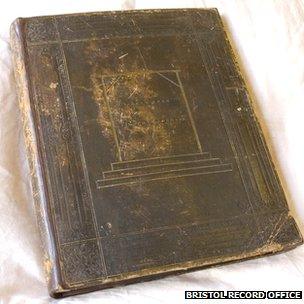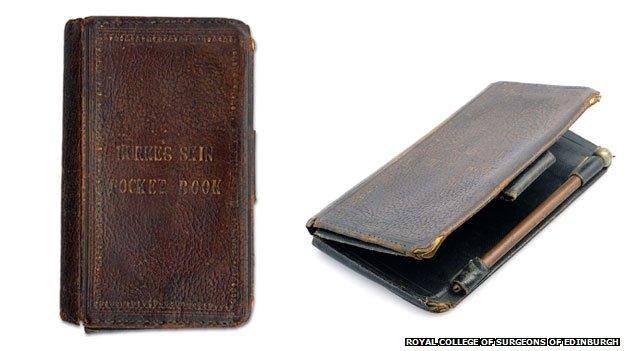The macabre world of books bound in human skin
- Published

A book bound in human skin was recently discovered at Harvard University. The grim tale is not as unusual as you'd think, writes Erin Dean.
A book owned by Harvard University library recently revealed its grisly history, when scientists confirmed that it was bound in human skin.
Staff at the university believe that the book, Des Destinees de l'Ame (Destinies of the Soul), was covered with the skin of an unclaimed female mental patient who died of natural causes. Writer Arsene Houssaye is said to have given the book in the mid 1880s to his friend, Dr Ludovic Bouland, who apparently carried out the unusual binding.
Covering books in human skin, known as anthropodermic bibliopegy, was a particular subject of interest in the 19th Century, although it is understood the practice goes back further.
One of the few surviving examples in the UK is owned by the Bristol Record Office and made from the skin of the first man to be hanged at Bristol Gaol. Its embossed dark brown cover was made with the skin of 18-year-old John Horwood, who was hanged for the murder of Eliza Balsum.

The book contains the details of the 1821 crime, when Horwood, who had become infatuated with Balsum and previously threatened to kill her, threw a stone at her while she was walking to a well to fetch water. According to the book, Horwood "took up a large stone and with the utmost savage ferocity nearly beat her skull to pieces". Balsum's screams brought her friends running, and she was taken to hospital, where she died from the head injury.
Following his trial and execution, Horwood's corpse was dissected by surgeon Richard Smith during a public lecture at the Bristol Royal Infirmary. Smith then decided to have part of Horwood's skin tanned to bind a collection of papers about the case. The cover of the book was embossed with a skull and crossbones, with the words "Cutis Vera Johannis Horwood", meaning "the actual skin of John Horwood", added in gilt letters.

The funeral of John Horwood
.jpg)
John Horwood was sentenced to death in 1821 and his body was used for dissection classes at the Bristol Royal Infirmary
His skeleton was discovered hanging in a cupboard by distant relative Mary Halliwell, who arranged for her great-great-great grandfather's brother to be buried
His funeral took place, external exactly 190 years to the hour when Horwood was hanged

The book, now on display in Bristol's M Shed museum, is one of the most popular in the archives, says senior archivist Allie Dillon. It's conserved in the same way as any other leather-bound text, and kept in suitable atmospheric conditions. "I think it is a really sad story," she says. "John Horwood seems to have been quite a vulnerable person and this may have contributed to his actions. It does seem very macabre to cover a book in human skin and it is quite difficult to understand why it was done. It seems quite vengeful to me."

On the back cover of the William Burke pocket book is inscribed the date of his execution - 28 January 1829
Another book with a sinister background is made from the skin of the infamous murderer, William Burke. Rather than dig up corpses to sell for dissection to the private Edinburgh anatomy school run by Robert Knox, Burke, along with his partner William Hare, began killing people instead. They sold more than 15 bodies before they were discovered.
The cover of the small brown pocket book, external, which has no pages but would have been used to store personal notes and money, is stamped with the execution date of Burke in 1829. How the skin ended up on the pocket book, which is in the Royal College of Surgeons of Edinburgh's museum, is a mystery.
"There was a public dissection and it was reported that part of the skin went missing and then soon after this book turned up for sale in Edinburgh," says Emma Black, from the college. "The production of this book followed a trend in which body parts of executed criminals were considered to be a type of talisman."
Other criminals who appear to have given up part of their skin for books include Devon murderer George Cudmore, who was hanged for poisoning his wife, and William Corder, convicted of killing Maria Marten in the crime dubbed the Red Barn Murder in Suffolk in 1827.
.jpg)
English murderer William Corder was executed at the gallows in Bury St. Edmunds, Suffolk in 1828
Interest in binding books in skin peaked in the 19th Century, says Simon Chaplin, head of the Wellcome Library, which holds books on medical history. The library has one book bound in skin, a 16th Century text on virginity that was rebound in human skin in the 19th Century, also by Ludovic Bouland.
"There are not a huge number of these books out there, it has been an occasional practice mainly done for generating a sense of vicarious excitement than for a practical motive," he says. "It generally seems to have been done in the 19th Century by doctors who had access to human bodies for dissection."
There is an ethical question. Many museum collections contain body parts, and in recent years some of these items have been returned to the countries they originally came from. This includes mummified Maori heads returned to New Zealand, and bones and other body parts repatriated to Australia and North America. This could raise questions about why these books bound in human skin continue to be seen as curiosities that often remain on public display.
But the tiny number of skin-bound books may mean this issue never generates significant controversy.
The Wellcome Library thought it had three books bound in human skin, but only one transpired to be genuine.
"There may be books out there reported to be covered in skin which aren't, and others that are covered in human skin but aren't known," says Chaplin.

The Wellcome Library's book on virginity - "This curious little book on virginity and the female reproductive functions seems to me worth of a binding appropriate to the subject and covered by a portion of female skin, tanned by myself with sumac. " Dr Ludovic Bouland
Subscribe to the BBC News Magazine's email newsletter to get articles sent to your inbox.